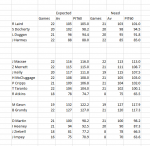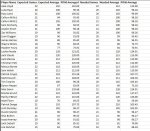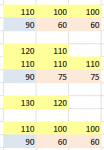One of the things I'm always stressing in Questions For Rowsus, is the importance of setting and having reasonable expectations for your players. This is not always an easy thing to do. Also added into the complexity of the problem, is the fact people have different levels for that player to achieve, to be considered a good pick.
One of the things people usually over estimate in setting their expectations, is the number of games the player might play that season.
As a guide, in 2020 111 players played all 17 Home & Away games. In 2019 there were 108 players to play all 22 Home & Away games. Thar'san average of only 5 to 6 players per team.
So if we collectively set both expectations and needs for different players, we can collate the results, and you can see if you are setting reasonable expectations, or you are outside of what other people are thinking.
So we are looking for 2 things in this thread.
We want to give a number for a player as to what you expect thay can achieve ie. M Gawn 18/127
Then we want you to give a number for what you think that player needs to achieve, as a minimum, for you to call him a good starting pick in your team. ie M Gawn 19/135
Choose any player you like. Certainly choose players that others have already given an opinion on, that way we start to see a range of opinions.
I will ask, if you are going to one extreme or another, we would like a reasonable explanation as to why.
ie I think M Gawn will go 22/150 this season, as he's fitter than he's ever been, and with the extra game time this year, he'll only record even more stats.
Or
I think Gawn will go 17/110 this season. The longer games will find him out, and I'm expecting more injuries, and injury scores.
For the Stepping Stone type players, you can give numbers like:
Ziebell - think 18/82, need 7/10/78 translates as:
I think he can have an 18/82 season, but I only need him to play 7 out of 10 and average 78 for me to consider him a good pick
You get the idea. If we keep it genuine, it should help people with some of their difficult selections.
Here is a PIT60 conversion table, to help you decide what is a good result or not.
It's simple to use. eg. If you think J Kelly will go 18/120 this season, you can see on the table his value to your team is 109.1.

For those unfamiliar with the PIT60 concept, it allocates a value of 60 points to the games a player misses (a Rookie score), and adjusts their average accordingly.
It will be fun at seasons end, to look back at this, and see how well we have done with our expectations/predictions!
One of the things people usually over estimate in setting their expectations, is the number of games the player might play that season.
As a guide, in 2020 111 players played all 17 Home & Away games. In 2019 there were 108 players to play all 22 Home & Away games. Thar'san average of only 5 to 6 players per team.
So if we collectively set both expectations and needs for different players, we can collate the results, and you can see if you are setting reasonable expectations, or you are outside of what other people are thinking.
So we are looking for 2 things in this thread.
We want to give a number for a player as to what you expect thay can achieve ie. M Gawn 18/127
Then we want you to give a number for what you think that player needs to achieve, as a minimum, for you to call him a good starting pick in your team. ie M Gawn 19/135
Choose any player you like. Certainly choose players that others have already given an opinion on, that way we start to see a range of opinions.
I will ask, if you are going to one extreme or another, we would like a reasonable explanation as to why.
ie I think M Gawn will go 22/150 this season, as he's fitter than he's ever been, and with the extra game time this year, he'll only record even more stats.
Or
I think Gawn will go 17/110 this season. The longer games will find him out, and I'm expecting more injuries, and injury scores.
For the Stepping Stone type players, you can give numbers like:
Ziebell - think 18/82, need 7/10/78 translates as:
I think he can have an 18/82 season, but I only need him to play 7 out of 10 and average 78 for me to consider him a good pick
You get the idea. If we keep it genuine, it should help people with some of their difficult selections.
Here is a PIT60 conversion table, to help you decide what is a good result or not.
It's simple to use. eg. If you think J Kelly will go 18/120 this season, you can see on the table his value to your team is 109.1.

For those unfamiliar with the PIT60 concept, it allocates a value of 60 points to the games a player misses (a Rookie score), and adjusts their average accordingly.
It will be fun at seasons end, to look back at this, and see how well we have done with our expectations/predictions!












